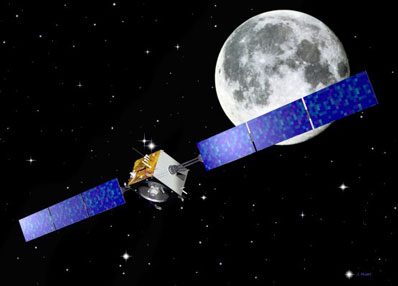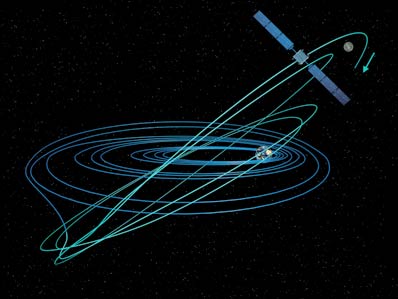Astronomy Picture of the Day
Discover the cosmos! Each day a different image or photograph of our fascinating universe is featured, along with a brief explanation written by a professional astronomer.
Posted on 10/22/2004 3:31:17 PM PDT by petuniasevan
Discover the cosmos! Each day a different image or photograph of our fascinating universe is featured, along with a brief explanation written by a professional astronomer.
Explanation: The candy-dish appearance of this high-tech astronomical mirror is striking. Made of a special glass ceramic material called Zerodur, it actually measures 2.7 meters across. The transparent surface has not yet received a reflective coating, so the weight-reducing internal honeycomb structure is visible with attractive blue and yellow tints provided by a protective tarp and background lighting. Recently unveiled, the telescope mirror is destined to fly on the Stratospheric Observatory For Infrared Astronomy (SOFIA). Since water vapor in Earth's troposphere tends to block infrared light, SOFIA will operate from a modified Boeing 747 jetliner at altitudes above 40,000 feet. As the largest airborne observatory in the world, SOFIA will explore a host of cosmic environments including sites of star birth and death, the formation of distant solar systems, and black holes in active galaxies.
There was a ceremonial changing of the guard aboard the International Space Station today as the departing Expedition 9 crew members handed control to their replacements in advance of Saturday's return to Earth.
After six months circling the planet aboard the station, Expedition 9 commander Gennady Padalka and flight engineer Michael Fincke are homeward bound to complete their long-duration voyage.
The two men and visiting cosmonaut researcher Yuri Shargin will strap inside the Soyuz TMA-4 capsule Saturday afternoon and depart the outpost, setting the stage for a three-and-a-half-hour trek to landing in Kazakhstan.
The station is being left to Expedition 10 commander Leroy Chiao and flight engineer Salizhan Sharipov for another half-year mission. They launched to the station last week on Soyuz TMA-5 along with Shargin.
"We are leaving you a space station that is even more capable than we received it. Please care well for this spacecraft," Padalka said during the handover ceremony around 11:15 a.m. EDT (1515 GMT).
"We accept responsibility and command of this fine space station," Chiao replied. "We will carry on the work of the partnership and pledge to carry on the legacy of human spaceflight."
The five men exchanged handshakes, hugs and rang the station's bell.
Expedition 9 will be the fourth consecutive station resident crew to return in Soyuz spacecraft after the Columbia accident grounded the shuttle fleet.
"Our Soyuz has been a really trusty ship and it's definitely ready to go," Fincke said earlier this week.
Preparations for the homecoming begin as Padalka, Fincke and Shargin enter the Soyuz craft currently docked to the station's Zarya module. It is the same ship Expedition 9 launched aboard in April. Hatches between the capsule and station are scheduled for closure at 2 p.m. EDT (1800 GMT) Saturday.
Fincke will be seated in the Soyuz craft's left seat as flight engineer, Padalka will be in the center commander's seat and Shargin will occupy the right seat. They will work together to active the craft's systems and ready for undocking.
The command to begin opening hooks and latches firmly holding Soyuz to its Earth-facing docking port will be sent at 5:05 p.m. EDT (2105 GMT). Physical separation between the two craft occurs three minutes later as the capsule backs away at just one-tenth of a meter per second.
After moving about 20 meters from the station, the Soyuz engines will fire for eight seconds at 5:11 p.m. EDT (2111 GMT) to execute the so-called separation burn to propel the craft a substantial distance from the complex.
About two-and-a-half hours later, Soyuz will be 19 kilometers from the station. The capsule's engines will ignite for the four-minute, 20-second deorbit burn to brake from space. The onboard computers will initiate an engine firing at 7:42:37 p.m. EDT (2342:37 GMT) that slows the ship by 115.2 meters/sec, just enough to slip out of orbit for the return to Earth.
Just before reaching the top of the atmosphere, the Soyuz's three distinct modules will separate at 8:08:35 p.m. EDT (0008:35 GMT) under computer command. The crew will be located in the Descent Module, which is sandwiched between the forward Orbital Module containing the docking mechanism and the rear Instrumentation and Propulsion Module housing the engines and avionics.
The Descent Module orients itself to point the ablative heat shield in the direction of travel to protect the craft and crew from the intense plunge back to Earth. At 8:11:39 p.m. EDT (0011:39 GMT), the moment of Entry Interface occurs as the capsule hits the upper fringes of the atmosphere for the fiery re-entry.
During the fall homeward, the Orbital Module and Instrumentation and Propulsion Module will burn up in the atmosphere.
Six minutes after Entry Interface, the crew will experience the period of maximum G-loads during entry as they feel the tug of Earth's gravity for the first time since launch.
At 8:20:38 p.m. EDT (0020:38 GMT), the onboard computers will start a commanded sequence for deployment of the capsule's parachutes at an altitude of about 10 kilometers. Two "pilot" parachutes are unfurled first, extracting a 24-square-meter drogue parachute. Within 16 seconds, the craft's fall will slow from 230 meters per second to about 80 m/s.
The parachute deployment creates a gentle spin for the Soyuz as it dangles underneath the drogue chute, assisting in the capsule's stability in the final minutes before touchdown.
The drogue chute will be jettisoned, allowing the main parachute to be deployed. It is connected to the Descent Module by two harnesses, covers an area of about 1,000 square meters and slows descent to 7.2 meters/second.
Initially, the Descent Module will hang underneath the main parachute at a 30-degree angle with respect to the horizon for aerodynamic stability, but the bottommost harness will be severed a few minutes before landing, allowing the Descent Module to hang vertically through touchdown.
At an altitude of just over 5 kilometers, the heat shield will be cast free. That is followed by dumping of any residual propellant from the Soyuz.
Once the heat shield is gone, the Soyuz altimeter is exposed to the surface of the Earth. Using a reflector system, signals are bounced to the ground from the Soyuz and reflected back, providing the capsule's computers updated information on altitude and rate of descent.
At an altitude of about 12 meters, cockpit displays will tell Padalka to prepare for the soft landing engine firing. Just one meter above the surface, and just seconds before touchdown, the six solid propellant engines are fired in a final braking maneuver, enabling the Soyuz to land to complete its mission, settling down at a velocity of about 1.5 meters per second.
Touchdown is expected at 8:35:38 p.m. EDT (0035:38 GMT) on the steppes of north-central Kazakhstan, about 97 minutes before sunrise at the landing site. Expedition 9 concludes with a duration of 187 days, 21 hours and 16 minutes.
A group of Russian military helicopters carrying the recovery forces, including a U.S. flight surgeon and astronaut support personnel, should arrive soon after landing to help the crew exit the capsule.
Each crew member will be placed in special reclining chairs near the capsule for initial medical tests and begin readapting to Earth's gravity. They will be transferred into a portable medical tent erected near the touchdown point where the three men can remove their spacesuits.
Post-landing plans call for the crew to be flown from the site in helicopters within two hours of landing. They will be taken to the city of Kustanai for an initial welcoming ceremony. Then a Russian military transport plane will fly the crew to the Gagarin Cosmonaut Training Center in Star City, Russia, where their families will meet them.
The crew undergoes more than two weeks of medical tests and physical rehabilitation before Padalka and Fincke can return to the U.S. for additional debriefings and follow-up exams.
European probe on track for its Moon encounter
EUROPEAN SPACE AGENCY NEWS RELEASE
Posted: October 18, 2004
From October 10 to 14, the ion engine of Euoprean Space Agency's SMART-1 carried out a continuous thrust manoeuvre in a last major push that will get the spacecraft to the Moon capture point on November 13.
 An artist's concept of SMART 1 and its destination -- our moon. Credit: ESA |
The SMART-1 mission was designed to pursue two main objectives. The first is purely technological: to demonstrate and test a number of space techniques to be applied to future interplanetary exploration missions. The second goal is scientific, mainly dedicated to lunar science. It is the technology demonstration goal, in particular the first European flight test of a solar-powered ion engine as a spacecraft's main propulsion system, that gave shape to the peculiar route and duration (13 months) of the SMART-1 journey to the Moon.
The long spiralling orbit around Earth, which is bringing the spacecraft closer and closer to the Moon, is needed for the ion engine to function and be tested over a distance comparable to that a spacecraft would travel during a possible interplanetary trip. The SMART-1 mission is also testing the response of a spacecraft propelled by such an engine during gravity-assisted manoeuvres. These are techniques currently used on interplanetary journeys, which make use of the gravitational pull of celestial objects (e.g. planets) for the spacecraft to gain acceleration and reach its final target while saving fuel.
In SMART-1's case, the Moon's gravitational pull has been exploited in three "lunar resonance" manoeuvres. The first two successfully took place in August and September 2004. The last resonance manoeuvre was on October 12, during the last major ion engine thrust, which lasted nearly five days, from October 10 to 14. Thanks to this final thrust, SMART-1 will make two more orbits around Earth without any further need to switch on the engine, apart from minor trajectory correction if needed. The same thrust will allow the spacecraft to progressively fall into the natural sphere of attraction of the Moon and start orbiting around it from 13 November, when it is 60 000 kilometres from the lunar surface.
 This illustration shows SMART 1 maneuvering from Earth to the Moon. Credit: ESA |

YES! You too can be added to the APOD PING list! Just ask!
Thank you for the ping
Thank You.
After reading the details of Expedition 9, all I can think is SURELY those same brilliant engineering minds can develop a great totally-electric car that will go 500 miles without a charge. Or at least a hybrid that gets 300 miles per gallon.
Are the oil companies really blocking all the car technology?
Thanks for the interesting ping. Talk about precision....
Disclaimer: Opinions posted on Free Republic are those of the individual posters and do not necessarily represent the opinion of Free Republic or its management. All materials posted herein are protected by copyright law and the exemption for fair use of copyrighted works.